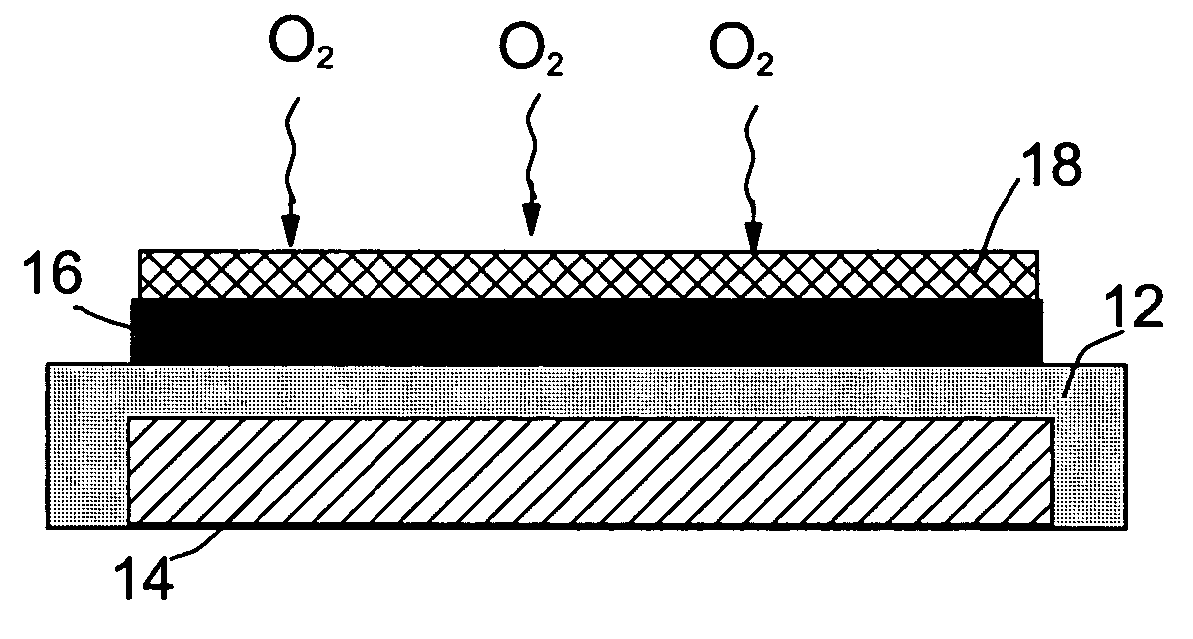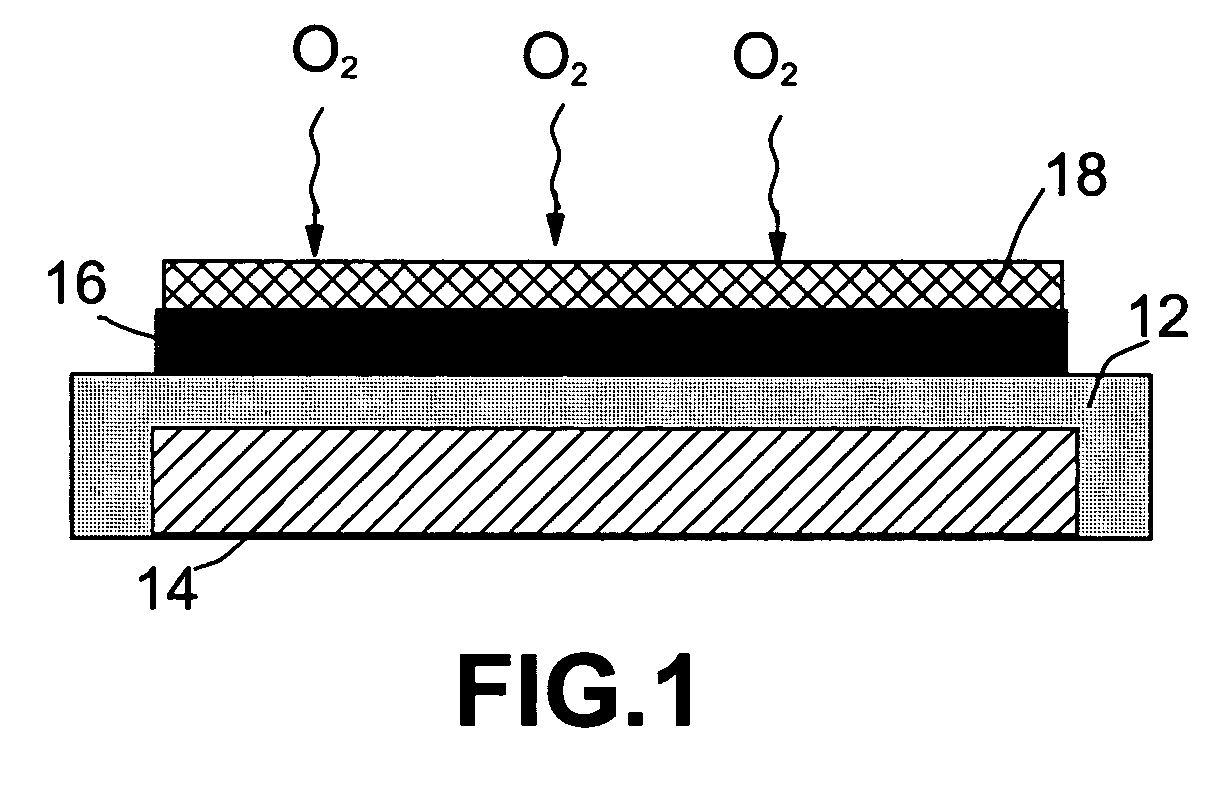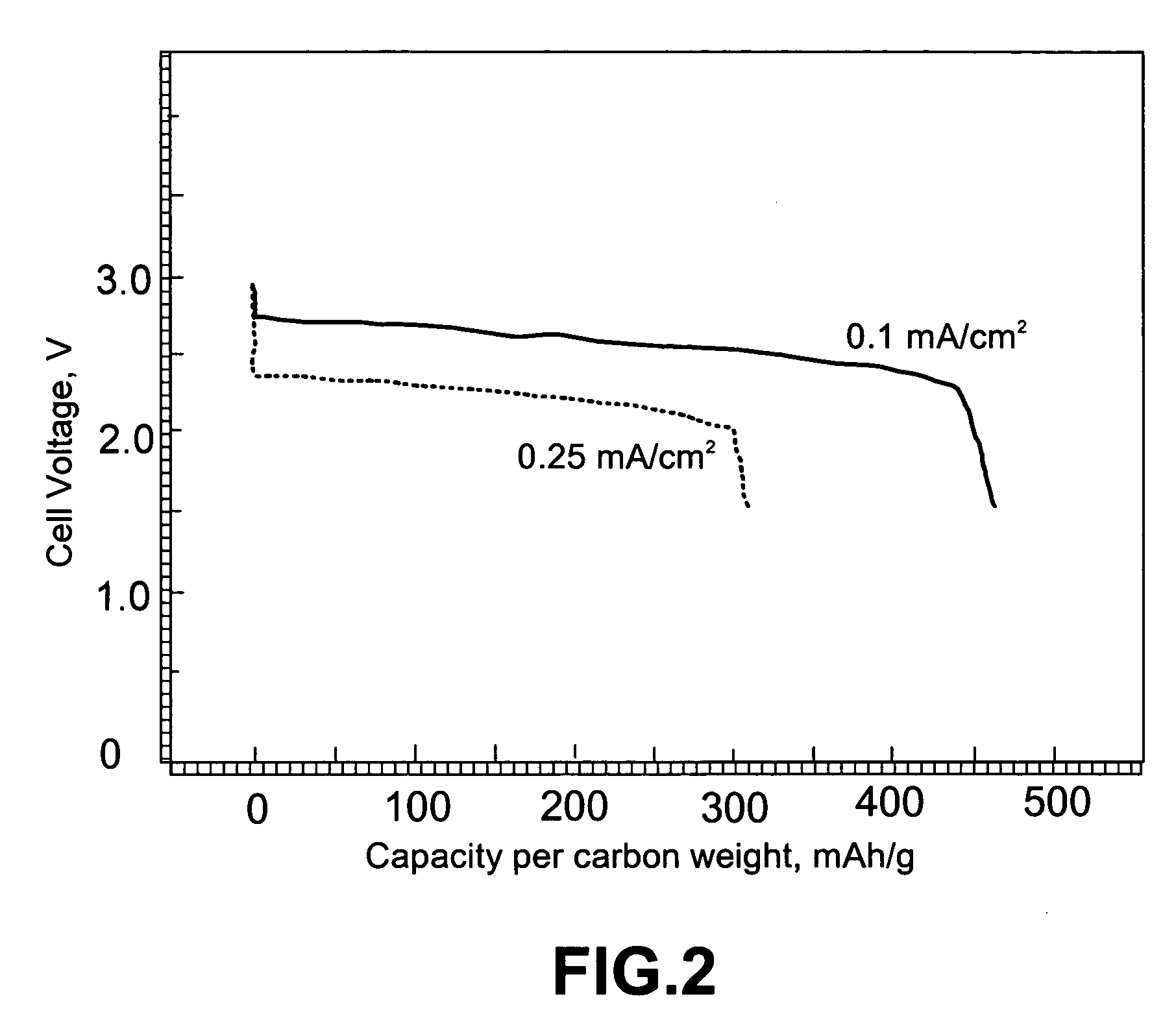Metal-air battery with ion-conducting inorganic glass electrolyte
a metal-air battery and inorganic glass technology, applied in the field of metal-air or metal-oxygen batteries, can solve the problems of metal anodes, na and li, and metal anodes suffer from severe corrosion problems
- Summary
- Abstract
- Description
- Claims
- Application Information
AI Technical Summary
Benefits of technology
Problems solved by technology
Method used
Image
Examples
example 1
[0033] A plasma-assisted CVD was used to prepare silicon oxide (SiOx)—(LiOx)-based films on Li-coated glass substrate by introduction of an organosilicon compound into a plasma reactor. Liquid organosilicon, 1,1,3,3-tetra-methyl-disiloxane, was slightly heated to produce a vapor pressure of the siloxane sufficient to sustain a silicon flux to the plasma. A radio frequency-heated Li—Al rod was used to generate a stream of Li vapor into the plasma chamber essentially concurrently with siloxane vapor. A metering valve and a mass flow meter connected in series were used to control the flux of organosilicon. The lithium silicate deposition was continued until the thickness was approximately 2,000 Å.
[0034] The carbon air electrode was prepared by mixing a 10 wt. % PTFE emulsion (containing 0.05 to 0.5 μm PTFE particles in water) with carbon black. The mixture was stirred and ultrasonicated for 10 minutes and then dried in a vacuum at 80° C. The dried paste was milled to form a fine powde...
example 2
[0036] A lithium metal thin film having a thickness of 10 μm was formed on a copper foil having a size of 100 mm×50 mm and a thickness of 10 μm by vacuum evaporation and deposition. On the thin film of the lithium metal, a thin film of an inorganic glass electrolyte was formed to have a thickness of 1 μm. The glass electrolyte was selected from the following list (Table 1):
TABLE 1The ion conductivity, open circuit voltage (OCV), and dischargevoltage (at a current density of 0.1 mA / cm2) of selectedLi / oxygen batteries.Dis-IonicchargeSam-Chemical compositionconductivityOCVVoltagepleof glass electrolyteS / cmVoltsVolts2-a60Li2S—39.5SiS2—0.5Li3PO41.8 × 10−32.862.602-b57Li2S—38SiS2—5(Li2O—P2O5)2.0 × 10−32.792.52-c57Li2S—38SiS2—5(Li4SiO4)2.0 × 10−32.852.562-d57Li2S—38SiS2—5Li3BO31.8 × 10−32.862.52
[0037] The carbon-based oxygen electrode and the resulting Li / glass electrolyte / carbon cell package for Samples 2-a through 2-d were prepared according to the same procedures as in Example 1.
example 3
[0038] Samples 3-a, 3-b, 3-c, and 3-d were similar to Samples 2-a, 2-b, 2-c, and 2-d, respectively; but the glass electrolyte layer was approximately 10 μm instead of 1 μm. The discharge voltages of the Li / O2 batteries with thicker electrolyte layers appear to be smaller than those of their thinner counterparts (Table 2).
TABLE 2The ion conductivity, open circuit voltage (OCV), anddischarge voltage (at a current density of 0.1 mA / cm2) ofselected Li / oxygen batteries.Dis-IonicchargeSam-Chemical compositionconductivityOCVVoltagepleof glass electrolyte (10 μm thick)S / cmVoltsVolts2-a60Li2S—39.5SiS2—0.5Li3PO41.8 × 10−32.852.512-b57Li2S—38SiS2—5(Li2O—P2O5)2.0 × 10−32.772.402-c57Li2S—38SiS2—5(Li4SiO4)2.0 × 10−32.832.442-d57Li2S—38SiS2—5Li3BO31.8 × 10−32.832.41
[0039] It may be noted that the performance of the presently invented metal-air batteries is comparable to that of the polymer / solvent-based metal-air batteries disclosed by Abraham and Jiang in U.S. Pat. No. 5,510,209, Apr. 23, 1996)...
PUM
| Property | Measurement | Unit |
|---|---|---|
| thickness | aaaaa | aaaaa |
| thickness | aaaaa | aaaaa |
| period of time | aaaaa | aaaaa |
Abstract
Description
Claims
Application Information
 Login to View More
Login to View More - R&D
- Intellectual Property
- Life Sciences
- Materials
- Tech Scout
- Unparalleled Data Quality
- Higher Quality Content
- 60% Fewer Hallucinations
Browse by: Latest US Patents, China's latest patents, Technical Efficacy Thesaurus, Application Domain, Technology Topic, Popular Technical Reports.
© 2025 PatSnap. All rights reserved.Legal|Privacy policy|Modern Slavery Act Transparency Statement|Sitemap|About US| Contact US: help@patsnap.com



